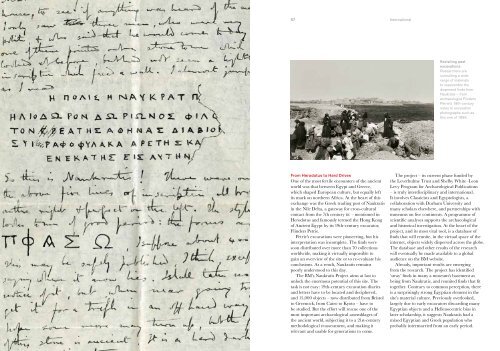12Review - British Museum
12Review - British Museum
12Review - British Museum
You also want an ePaper? Increase the reach of your titles
YUMPU automatically turns print PDFs into web optimized ePapers that Google loves.
57 International<br />
From Herodotus to Hard Drives<br />
One of the most fertile encounters of the ancient<br />
world was that between Egypt and Greece,<br />
which shaped European culture, but equally left<br />
its mark on northern Africa. At the heart of this<br />
exchange was the Greek trading post of Naukratis<br />
in the Nile Delta, a gateway for cross-cultural<br />
contact from the 7th century bc – mentioned in<br />
Herodotus and famously termed the Hong Kong<br />
of Ancient Egypt by its 19th-century excavator,<br />
Flinders Petrie.<br />
Petrie’s excavations were pioneering, but his<br />
interpretation was incomplete. The finds were<br />
soon distributed over more than 70 collections<br />
worldwide, making it virtually impossible to<br />
gain an overview of the site or to re-evaluate his<br />
conclusions. As a result, Naukratis remains<br />
poorly understood to this day.<br />
The BM’s Naukratis Project aims at last to<br />
unlock the enormous potential of this site. The<br />
task is not easy: 19th-century excavation diaries<br />
and letters have to be located and deciphered,<br />
and 15,000 objects – now distributed from Bristol<br />
to Greenock, from Cairo to Kyoto – have to<br />
be studied. But the effort will rescue one of the<br />
most important archaeological assemblages of<br />
the ancient world, subjecting it to a 21st-century<br />
methodological reassessment, and making it<br />
relevant and usable for generations to come.<br />
Revisiting past<br />
excavations<br />
Researchers are<br />
consulting a wide<br />
range of materials<br />
to reassemble the<br />
dispersed finds from<br />
Naukratis – from<br />
archaeologist Flinders<br />
Petrie’s 19th-century<br />
notes to excavation<br />
photographs such as<br />
this one of 1899.<br />
The project – its current phase funded by<br />
the Leverhulme Trust and Shelby White–Leon<br />
Levy Program for Archaeological Publications<br />
– is truly interdisciplinary and international.<br />
It involves Classicists and Egyptologists, a<br />
collaboration with Durham University and<br />
many scholars elsewhere, and partnerships with<br />
museums on five continents. A programme of<br />
scientific analyses supports the archaeological<br />
and historical investigation. At the heart of the<br />
project, and its most vital tool, is a database of<br />
finds that will reunite, in the virtual space of the<br />
internet, objects widely dispersed across the globe.<br />
The database and other results of the research<br />
will eventually be made available to a global<br />
audience on the BM website.<br />
Already, important results are emerging<br />
from the research. The project has identified<br />
‘stray’ finds in many a museum’s basement as<br />
being from Naukratis, and reunited finds that fit<br />
together. Contrary to common perception, there<br />
is a surprisingly strong Egyptian element in the<br />
site’s material culture. Previously overlooked,<br />
largely due to early excavators discarding many<br />
Egyptian objects and a Hellenocentric bias in<br />
later scholarship, it suggests Naukratis had a<br />
mixed Egyptian and Greek population who<br />
probably intermarried from an early period.

















